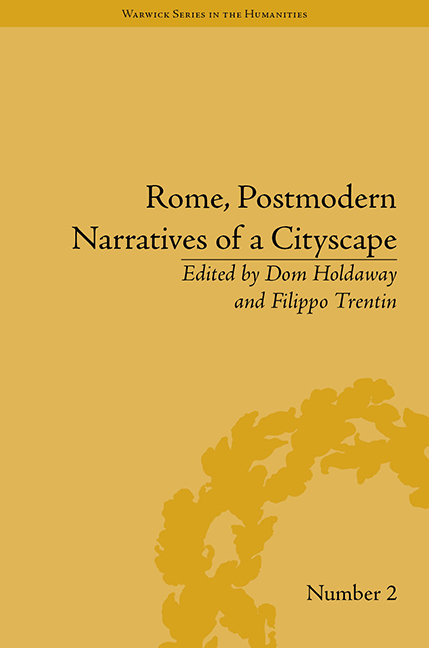Book contents
- Frontmatter
- Contents
- Acknowledgements
- List of Contributors
- List of Figures
- Introduction: Rome, Postmodern Narratives of a Cityscape
- Part I Knowing Rome
- Part II Fragmented Topography
- 4 Topophilia and Other Roman Perversions: On Bertolucci's La luna
- 5 Marcus Aurelius and the Ara Pacis: Notes on the Notion of ‘Origin’ in Contemporary Rome
- 6 A Postmodern Gaze on the Gasometer
- Part III Situating Rome
- Notes
- Index
5 - Marcus Aurelius and the Ara Pacis: Notes on the Notion of ‘Origin’ in Contemporary Rome
from Part II - Fragmented Topography
- Frontmatter
- Contents
- Acknowledgements
- List of Contributors
- List of Figures
- Introduction: Rome, Postmodern Narratives of a Cityscape
- Part I Knowing Rome
- Part II Fragmented Topography
- 4 Topophilia and Other Roman Perversions: On Bertolucci's La luna
- 5 Marcus Aurelius and the Ara Pacis: Notes on the Notion of ‘Origin’ in Contemporary Rome
- 6 A Postmodern Gaze on the Gasometer
- Part III Situating Rome
- Notes
- Index
Summary
Premise
In April 2008, Rome's administrative election ratified the victory of the right-wing coalition after almost twenty years of left-wing administration. This political change brought two Roman monuments to the centre of public attention. Soon after his election, the new mayor stated: ‘we'll move Richard Meier's museum for the Ara Pacis from Rome's city centre to its periphery.’ The structure to which he was referring, an ‘international-style’ building composed of glass, travertine marble and white concrete, had been blamed for having ‘disfigured’ the historical centre of Rome. At the same time, a group of his supporters were celebrating the victory of his election atop the replica of the Marcus Aurelius equestrian statue located at the centre of Piazza del Campidoglio, the heart of Rome's political power for more than 2,000 years. The continued public attention on these two landmarks of ‘classical’ Rome proves their enduring legacy even after a millenary history. How can one define these public sentiments? Is this an attachment to a tradition that is still relevant to our times, or is it simply a conventional and traditionalist gesture lacking any deeper meaning?
Introduction
The two global cities that are most oft en taken as the quintessential postmodern locations are the phantasmagorical urban imageries of Los Angeles and Las Vegas.
- Type
- Chapter
- Information
- Rome, Postmodern Narratives of a Cityscape , pp. 101 - 118Publisher: Pickering & ChattoFirst published in: 2014



